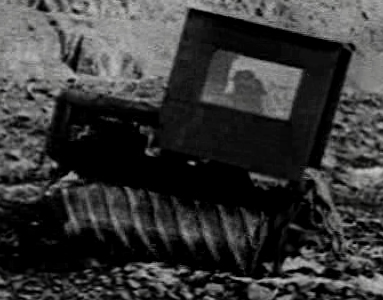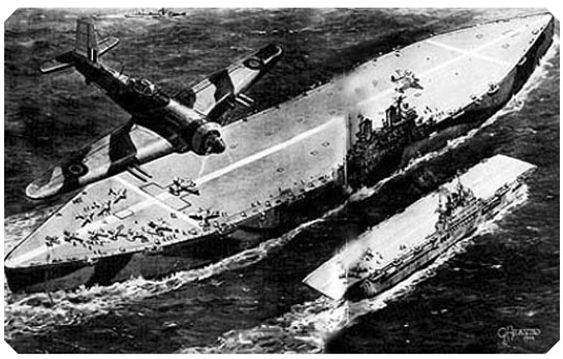Project Habakkuk
Building an aircraft carrier out of ice to fight German submarines? Sounds like something a bad fiction writer would dream up (cough.. *Dan Brown* cough)... but it actually happened.
Brits have always loved their boffins, and as a country it has been a little more accepting of the wild and wonderful than most. The aircraft carrier idea was dreamed up by General Pyke, a man who was often coming with innovative solutions..
Among his ideas was a screw canister based drive-train for an over-snow vehicle to attack the Germans in Scandinavia.
Eventually the Brits build this however, which is far less awesome (thought I would still like one):

But back to the point. The General Pyke invented Pykrete, a mixture of water and woodpulp which frozen together was stronger than plain ice, was slower melting, and of course would not sink. It has been suggested that Pyke was inspired by Inuit sleds reinforced with moss. It has also been suggested that General Pyke had a little too much time on his hands.
After some initial testing in a meatlocker in London.... yeah... central command decided to go ahead with building a prototype.
At Lake Louise, Alberta, large ice blocks were constructed, and a small prototype was constructed at Patricia Lake, Alberta, measuring only 60 by 30 feet (18 by 9 m), weighing in at 1,000 tons and kept frozen by a one-horsepower motor.[8] The work was done by conscientious objectors who did alternative service of various kinds instead of military service. They were never told what they were building.[citation needed] Bernal informed COHQ that the Canadians were building a 1,000 ton model, and that it was expected to take 8 men 14 days to build it. The Chief of Combined Operations (CCO) responded that Churchill had invited the Chiefs of Staff Committee to arrange for an order to be placed for one complete ship at once with the highest priority, with further ships to be ordered immediately if it appeared the scheme was certain of success.
The Canadians were confident about constructing a vessel for 1944. The necessary materials were available to them in the form of 300,000 tons of wood pulp, 25,000 tons of fibreboard insulation, 35,000 tons of timber and 10,000 tons of steel. The cost was estimated at £700,000.[9]
However... the problem of plastic flow had become serious and it was obvious that more steel reinforcement would be needed as well as a more effective insulating skin around the vessel's hull. This caused the cost estimate to increase to £2.5 million. In addition, the Canadians had decided that it was impractical to attempt the project "this coming season", and Bernal and Pyke were forced to conclude that no Habbakuk vessel would be ready in 1944
The final design of Habbakuk II gave the bergship (as it was referred to... and which is completely awesome) a displacement of 2.2 million tons. Steam turbogenerators were to supply 33,000 hp (25,000 kW) for 26 electric motors mounted in separate external nacelles (normal, internal ship engines would have generated too much heat for an ice craft). Its armament would have included 40 dual-barrelled 4.5" DP (dual-purpose) turrets and numerous light anti-aircraft guns, and it would have housed an airstrip and up to 150 twin-engined bombers or fighters.

Brits have always loved their boffins, and as a country it has been a little more accepting of the wild and wonderful than most. The aircraft carrier idea was dreamed up by General Pyke, a man who was often coming with innovative solutions..
 |
| The Germans were too busy saying "wft?" to shoot |
Eventually the Brits build this however, which is far less awesome (thought I would still like one):

But back to the point. The General Pyke invented Pykrete, a mixture of water and woodpulp which frozen together was stronger than plain ice, was slower melting, and of course would not sink. It has been suggested that Pyke was inspired by Inuit sleds reinforced with moss. It has also been suggested that General Pyke had a little too much time on his hands.
| A block of Pykrete... apparently after a redneck mistook it for a deer |
After some initial testing in a meatlocker in London.... yeah... central command decided to go ahead with building a prototype.
At Lake Louise, Alberta, large ice blocks were constructed, and a small prototype was constructed at Patricia Lake, Alberta, measuring only 60 by 30 feet (18 by 9 m), weighing in at 1,000 tons and kept frozen by a one-horsepower motor.[8] The work was done by conscientious objectors who did alternative service of various kinds instead of military service. They were never told what they were building.[citation needed] Bernal informed COHQ that the Canadians were building a 1,000 ton model, and that it was expected to take 8 men 14 days to build it. The Chief of Combined Operations (CCO) responded that Churchill had invited the Chiefs of Staff Committee to arrange for an order to be placed for one complete ship at once with the highest priority, with further ships to be ordered immediately if it appeared the scheme was certain of success.
The Canadians were confident about constructing a vessel for 1944. The necessary materials were available to them in the form of 300,000 tons of wood pulp, 25,000 tons of fibreboard insulation, 35,000 tons of timber and 10,000 tons of steel. The cost was estimated at £700,000.[9]
However... the problem of plastic flow had become serious and it was obvious that more steel reinforcement would be needed as well as a more effective insulating skin around the vessel's hull. This caused the cost estimate to increase to £2.5 million. In addition, the Canadians had decided that it was impractical to attempt the project "this coming season", and Bernal and Pyke were forced to conclude that no Habbakuk vessel would be ready in 1944
 |
| Winning |
At that, the maximum Speed would only be six knots. (By leaving the ice out and converting the tubing to ship's plates the whole would have been able to go four times as fast.).
But there was one obstacle that even research and faith could not overcome.. Great Britain hadn't the resources to build even one Habakkuk. Ahh well. We won the war anyway... but this still would have been awesome...

Comments
Post a Comment